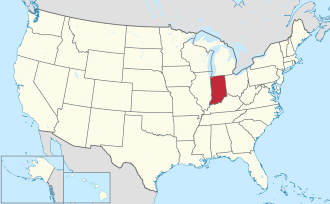History
Jackson County was formed in 1816. It was named after General Andrew Jackson. [3]
Jackson County was the site of the first recorded train robbery of a moving train in the United States. On October 6, 1866, the Reno Gang robbed an Ohio and Mississippi Railway train, making off with over $10,000. [4]
Jackson County has the second longest 3-span covered bridge in the world; The Medora Covered Bridge. After a recent project to completely refurbish the Medora Covered Bridge, the nearby town of Medora now holds an annual event at the bridge. The bridge is open for pedestrian traffic and site-seers. Another long neglected covered bridge, the Bells Ford Bridge, believed to have been the last remaining Post Truss bridge in the world, succumbed to neglect, collapsing into the White River on January 2, 2006.
Demographics
Historical population| Census | Pop. | Note | %± |
|---|
| 1820 | 4,010 | | — |
|---|
| 1830 | 4,870 | | 21.4% |
|---|
| 1840 | 8,961 | | 84.0% |
|---|
| 1850 | 11,047 | | 23.3% |
|---|
| 1860 | 16,286 | | 47.4% |
|---|
| 1870 | 18,974 | | 16.5% |
|---|
| 1880 | 23,050 | | 21.5% |
|---|
| 1890 | 24,139 | | 4.7% |
|---|
| 1900 | 26,633 | | 10.3% |
|---|
| 1910 | 24,727 | | −7.2% |
|---|
| 1920 | 24,228 | | −2.0% |
|---|
| 1930 | 23,731 | | −2.1% |
|---|
| 1940 | 26,612 | | 12.1% |
|---|
| 1950 | 28,237 | | 6.1% |
|---|
| 1960 | 30,556 | | 8.2% |
|---|
| 1970 | 33,187 | | 8.6% |
|---|
| 1980 | 36,523 | | 10.1% |
|---|
| 1990 | 37,730 | | 3.3% |
|---|
| 2000 | 41,335 | | 9.6% |
|---|
| 2010 | 42,376 | | 2.5% |
|---|
| 2020 | 46,428 | | 9.6% |
|---|
| 2023 (est.) | 46,460 | [10] | 0.1% |
|---|
|
As of the 2010 United States census, there were 42,376 people, 16,501 households, and 11,629 families residing in the county. [16] The population density was 83.2 inhabitants per square mile (32.1/km2). There were 18,202 housing units at an average density of 35.7 per square mile (13.8/km2). [5] The racial makeup of the county was 94.5% white, 0.8% Asian, 0.7% black or African American, 0.2% American Indian, 0.1% Pacific islander, 2.4% from other races, and 1.3% from two or more races. Those of Hispanic or Latino origin made up 5.7% of the population. [16] In terms of ancestry, 28.8% were German, 13.1% were American, 12.8% were Irish, and 9.2% were English. [17]
Of the 16,501 households, 33.7% had children under the age of 18 living with them, 54.4% were married couples living together, 10.8% had a female householder with no husband present, 29.5% were non-families, and 24.4% of all households were made up of individuals. The average household size was 2.53 and the average family size was 2.98. The median age was 38.7 years. [16]
The median income for a household in the county was $47,697 and the median income for a family was $53,534. Males had a median income of $38,608 versus $30,030 for females. The per capita income for the county was $21,498. About 7.6% of families and 11.1% of the population were below the poverty line, including 13.7% of those under age 18 and 6.3% of those age 65 or over. [18]
This page is based on this
Wikipedia article Text is available under the
CC BY-SA 4.0 license; additional terms may apply.
Images, videos and audio are available under their respective licenses.



